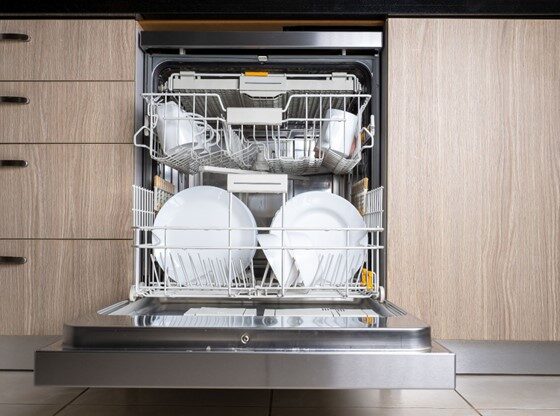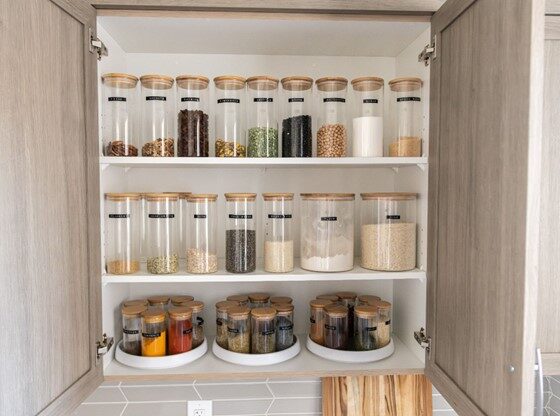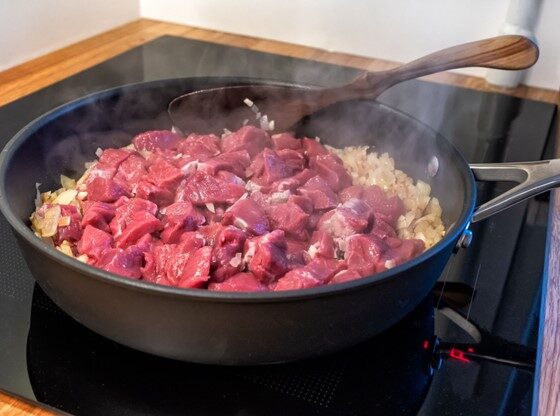In the ever-evolving world of culinary technology, induction cooking has emerged as a revolutionary method that is changing the way we prepare meals. Unlike traditional gas or electric stovetops, induction cooking relies on advanced electromagnetic technology to heat cookware directly. In this blog, we will explore what is induction cooking, understand how it works, and check the numerous benefits it offers.

What is Induction Cooking and how does it Work?
Induction cooking utilizes magnetic fields to create heat directly in the cookware itself. A coil beneath the glass-ceramic surface of the induction cooktop generates an electromagnetic field when an electric current passes through it. When compatible cookware is placed on the cooktop, the magnetic field induces an electric current in the metal, producing heat. This is a targeted and efficient process that ensures rapid heating and precise temperature control, giving chefs and home cooks alike an unparalleled cooking experience.

The fundamental principle behind induction cooking lies in the generation of electromagnetic fields. Here is a step-by-step breakdown of how it works:
1.Electromagnetic Coil: Beneath the smooth glass-ceramic surface of an induction cooktop, there is a coil of conductive material. When an electric current passes through this coil, it creates a rapidly changing magnetic field.
- Magnetic Field Induction: When compatible cookware, usually made of ferrous (magnetic) materials like cast iron or stainless steel, is placed on the cooktop, the magnetic field induces an electric current in the metal of the cookware.
- Resistance Heating: The induced electric current in the cookware encounters resistance, generating heat directly within the metal. This process is highly efficient, as it heats the cookware itself rather than relying on a heating element or an open flame.
- Instant Heat: Unlike traditional cooking methods, which involve heating a surface and then transferring that heat to the cookware, induction cooking provides almost instantaneous and precise temperature control. The cookware heats up quickly, allowing for faster cooking times and enhanced control over the cooking process.
- Safety Features: One notable safety feature of induction cooking is that the cooktop remains relatively cool during operation. The heat is confined to the cookware, reducing the risk of burns. Additionally, many induction cooktops have automatic shut-off functions, enhancing safety further.
What is the Best Cookware Material for Induction Cooking?
The best cookware for induction cooking combines efficiency, durability, and style. Induction cooktops require cookware with a magnetic base, as the heat is generated directly through electromagnetic induction. Here are some types of cookware that are compatible with induction cooking:
- Cast Iron: Cast iron cookware, such as skillets and Dutch ovens, is highly compatible with induction cooking. The material is magnetic and efficiently conducts heat, making it an excellent choice for this cooking method.
- Magnetic Stainless Steel: Cookware made from magnetic stainless steel is a popular and versatile option for induction cooking. It often has a layer of magnetic material in the base to ensure compatibility.

- Enamel-Coated Cast Iron: Some enamel-coated cast iron cookware is induction-compatible, as the cast iron base provides the necessary magnetic properties. However, it is essential to check the manufacturer’s specifications to confirm compatibility.
- Induction-Ready Aluminum: While pure aluminum is not magnetic, some cookware manufacturers add a layer of magnetic material to the base of aluminum pans, making them suitable for induction cooking.
- Induction-Ready Copper: Similar to aluminum, copper itself is not magnetic. However, some copper cookware comes with a magnetic layer or base, ensuring compatibility with induction cooktops.
- Tri-Ply Stainless Steel: Cookware with a tri-ply construction, typically consisting of an aluminum core sandwiched between layers of stainless steel, is often induction-compatible. The magnetic stainless steel base ensures efficient heat transfer.
- Induction-Ready Cookware Sets: Many cookware manufacturers offer sets specifically designed for induction cooking. These sets typically include a variety of pots and pans made from compatible materials, ensuring a seamless cooking experience.
The bottom of the pan must have some iron content. 100% copper, 100% aluminum or non-magnetic stainless steel will not work.

Testing Cookware in the Parameters of Induction Cooking
Testing cookware for induction compatibility is a simple and easy process that involves checking whether the cookware has a magnetic base, which is necessary for induction cooking. Here is a simple step-by-step guide on how to test your cookware:
Materials Needed:
- A strong magnet
Procedure:
- Select a Magnet:
Choose a strong magnet, such as a refrigerator magnet or any other powerful magnet you have available.
- Clean the Cookware:
Ensure that the bottom of the cookware is clean and dry. Any residue or moisture might affect the test results.
- Test the Magnet:
- Place the magnet on the bottom of the cookware.
- If the magnet sticks firmly and securely to the bottom, the cookware is induction-compatible.
- If the magnet does not stick or sticks weakly, the cookware may not be suitable for induction cooking.
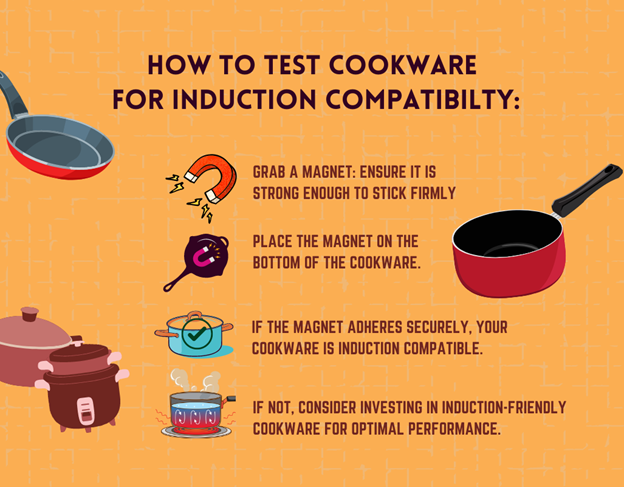
- Repeat for Various Parts:
Test different areas on the bottom of the cookware, especially if the base has multiple layers or materials. Some cookware might have a magnetic layer only in specific sections.
- Check for Labels or Symbols:
Examine the cookware for any labels or symbols that indicate induction compatibility. Manufacturers often provide this information on the packaging or on the cookware itself.
- Refer to Manufacturer’s Instructions:
Check the product information provided by the manufacturer. It may contain details about the cookware’s compatibility with induction cooktops.
- Seek Professional Advice:
If you are uncertain about the compatibility of your cookware, consult with the manufacturer or a professional kitchen appliance expert. They can provide guidance and ensure that you are using the right cookware for your induction cooktop.
Note: It is important to note that aluminum and copper cookware are generally not magnetic and may not work with induction cooktops unless they have a magnetic base or an added layer that makes them compatible.
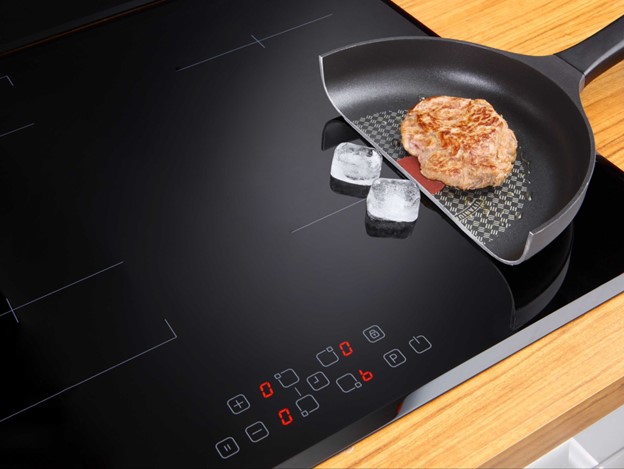
Benefits of Induction Cooking:
Now that we have explored the concept and steps involved in its working, let us now check the benefits of induction cooking:
- Energy Efficiency: Induction cooking is highly energy-efficient as it heats the cookware directly, wasting minimal heat. This translates to faster cooking times and reduced energy consumption.
- Precision Temperature Control: Induction cooktops allow for precise control over cooking temperatures. This level of accuracy is especially beneficial for delicate dishes that require specific heat levels.
- Safety Features: Induction cooktops remain cool to the touch, minimizing the risk of burns. Additionally, they feature auto-shutoff functions, ensuring safety in case cookware is removed or the cooktop is left unattended.
- Easy Cleanup: Since the cooktop itself does not get hot, spills and splatters are less likely to burn onto the surface. This makes cleaning up a breeze, saving both time and effort.
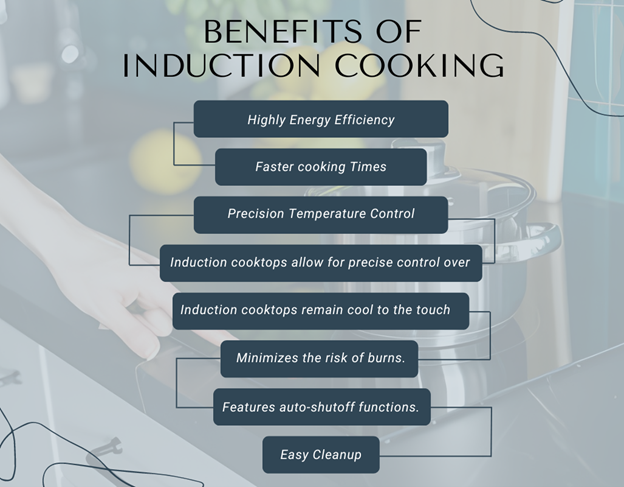
Wrapping up
In summary, induction cooking is a highly efficient and technologically advanced method that brings a new level of control and speed to the kitchen. It has undoubtedly become a game-changer in the kitchen, offering a combination of speed, efficiency, and safety. It not only cooks food faster but also offers safety features and precise temperature control, making it a preferred choice for modern cooking lovers.
